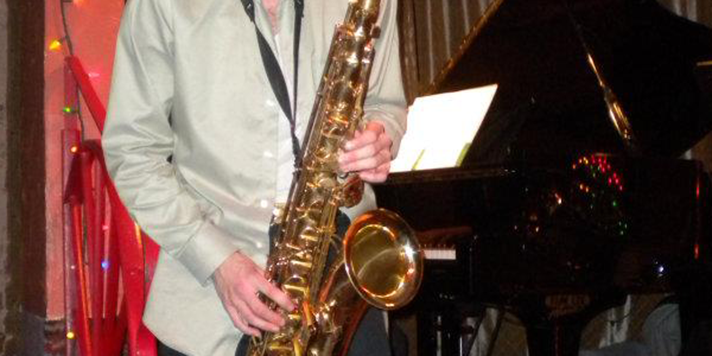This article is a guest post from Sean Winter.
The purpose of this article is to introduce the concept of playing outside of the given key centre of a song. Usually when we start out improvising we learn the scales related to whichever key we are playing in. Then the scales related to the specific chords in the song. The term “playing outside was popularized during the swing era when some players were starting to venture away from the confines of what was written on the page. During this time the roots of bebop were starting to form and the shift out of the swing era was under way.
Playing “outside” is not limited to bebop or any jazz for that matter. Modern masters of the saxophone such as Maceo Parker, Jeff Coffin or Joshua Redman have made great use of playing “outside” in Funk and Soul Music.
I want to discuss a few ways that the improviser can start incorporate “out” notes into their playing.
It’s important to realize that when we start to move away from the key centre that Intention is often more important than the notes themselves. That if you don’t know the theory behind what you are playing you are more likely to sound like you don’t know what you are doing and are just playing random notes.
Along with Intention is the understanding of “Tension” and “Resolution”. Tension could easily be described as when you ARE playing outside of the key and Resolution being when you come back to the original key. This is a very simple and easy to grasp way of looking at it. The longer you are playing outside of the key the more tension is created until you resolve back into the original key.
I’m going to discuss 3 devices that I think are a good starting point for playing outside of the key centre. Although there are many ways to do this we are going to discuss just these 3 for the beginner.
1) PATTERNS:
Patterns are a sequence of notes given a numerical value based on the degrees of the scale.
| C | D | E | F | G | A | B |
| 1 | 2 | 3 | 4 | 5 | 6 | 7 |
This Numbering system applies to all 12 keys. Shorter patterns (2,3,4 notes) are often called “motifs”.
A common pattern in bebop is 1-2-3-5. In C the first note being C, the Second being D, the third E and the fifth G.
This pattern can be used in many different ways. It can be applied to the given chord changes of a song to play inside and “Run the changes”. Or it can be used by the improviser in the context of playing outside.
The pattern would be put through a sequence at the liberty of the improviser depending on the situation to achieve those “Outside” sounds. These sequences being based on different intervals. Half Step, Whole Step, Minor thirds, Major Thirds, Fourths, Tritone etc
Arguably the Half step motion creates the most tension right away. Applying the above pattern in this way would look like:
| C-D-E-G | C#-D#-E#-G# | D-E-F#-A | Eb-F-G-Bb | E-F#-G#-B | and so on through the 12 keys. |
| 1 2 3 5 | 1 2 3 5 | 1 2 3 5 | 1 2 3 5 | 1 2 3 5 |
In fourths this would look like
| C-D-E-G | F-G-A-C | Bb-C-D-F | Eb-F-G-Bb | Ab-Bb-C-Eb |
| 1 2 3 5 | 1 2 3 5 | 1 2 3 5 | 1 2 3 5 | 1 2 3 5 |
There are many books with many other interesting patterns that you can check out. Jerry Coker’s Patterns for Jazz is pretty much considered to standard literature on this topic. If you are intrigued by this I suggest you go pick up a copy of his book.
2) SIDE STEPPING:
Side stepping is a different but similar approach to Patterns. It is similar in the sense that you are stepping into a different key but different because a pattern is not necessarily applied.
A good way of thinking about this is to consider when you just improvise over a major scale using just the notes from that scale or “Diatonically”. Side Stepping involves improvising in the one key and then switching to improvising Diatonically in a different key. This creates tension. Often the resolution is created by switching back to playing in the original key but the improviser can switch through multiple keys before resolving back to the original if they so choose.
Most commonly this technique is applied to soloing a half step away but can be run through any of the intervals at the improvisers discretion.
I should point out that many improvisers do not only play diatonically when Side Stepping. That when they are in the different key they are able to apply all the same alterations and patterns they would in the original key. The term diatonic is only being used to aid in the simple nature of what Side Stepping is all about.
A great example of this would be on the Live Maceo Parker recording “Shake Everything You’ve Got” where Maceo is playing along just with the drummer and goes through all of the keys in Half step motion before returning to the original key at which point the whole band comes back in. This is a well known and well used trick that got a lot of popularity in the early R/B days.
Other great Side Steppers are Kenny Garrett, Alex Han, Jeff Coffin, Joshua Redman, Michael Brecker and too many others to list. Check those players out for starters.
3) CHROMATIC TENSION ON THE CHORD TONES
This isn’t a phrase that is really tossed around. It is a well known and well used trick for playing outside that gets very immediate and noticeable results and is likely the simplest of the 3 to get playing “Outside”
The chord tones of whichever chords you are playing over are considered the strongest notes for improvising in key. It stands to reason that playing any of these notes a half step away would create some tension.
Two ways of doing this would be;
i) Simply to play one of the chord tones and then move to the note a half step away (up or down) and then back again.
For example if playing in the Key of F: Playing an F and then an F# and then back to an F would create a very obvious way of playing outside of the key. Also the same could be done for any of the chord tones 1-3-5-7-9. Playing on the fifth ( C ) you would Play C-C#-C.
ii) Still playing the chord tones but altering some or all of them by a half step.
Here is a quick exercise for doing this.
Play a Broken F7 Chord (F-A-C-Eb)
Now play a Broken F#dim7 Chord (F#-A-C-Eb)
Now play a Broken Faug7 Chord (F-A-C#-Eb)
Notice how the second and third chords are only 1 note being changed by a half step.
Experiment with all the keys and alter each of the chord tones (up and down) by a half step. This is a great way to get familiar with different chords and to hear the difference in the sound created by making chromatic tension in the chord tones.
In closing I want to say that this is a fairly broad topic. Many players are doing great work with playing outside the changes. These tips are meant to serve as a basis for beginning to play outside and that anyone interested in this topic should please feel free to check out any of the other great resources available.
Happy Playing!
 WRITTEN BY – Sean Winter, Saxophonist
WRITTEN BY – Sean Winter, Saxophonist
Sean Winter is a tenor saxophonist from Victoria, British Columbia. He is currently studying to better himself as a musician as well as playing gigs around town with Blues bands, Soul and Reggae bands. He also leads his own Fusion trio called Weapons of Mass Groove. Check out his bio on Teen Jazz.
[template id=”182″]
